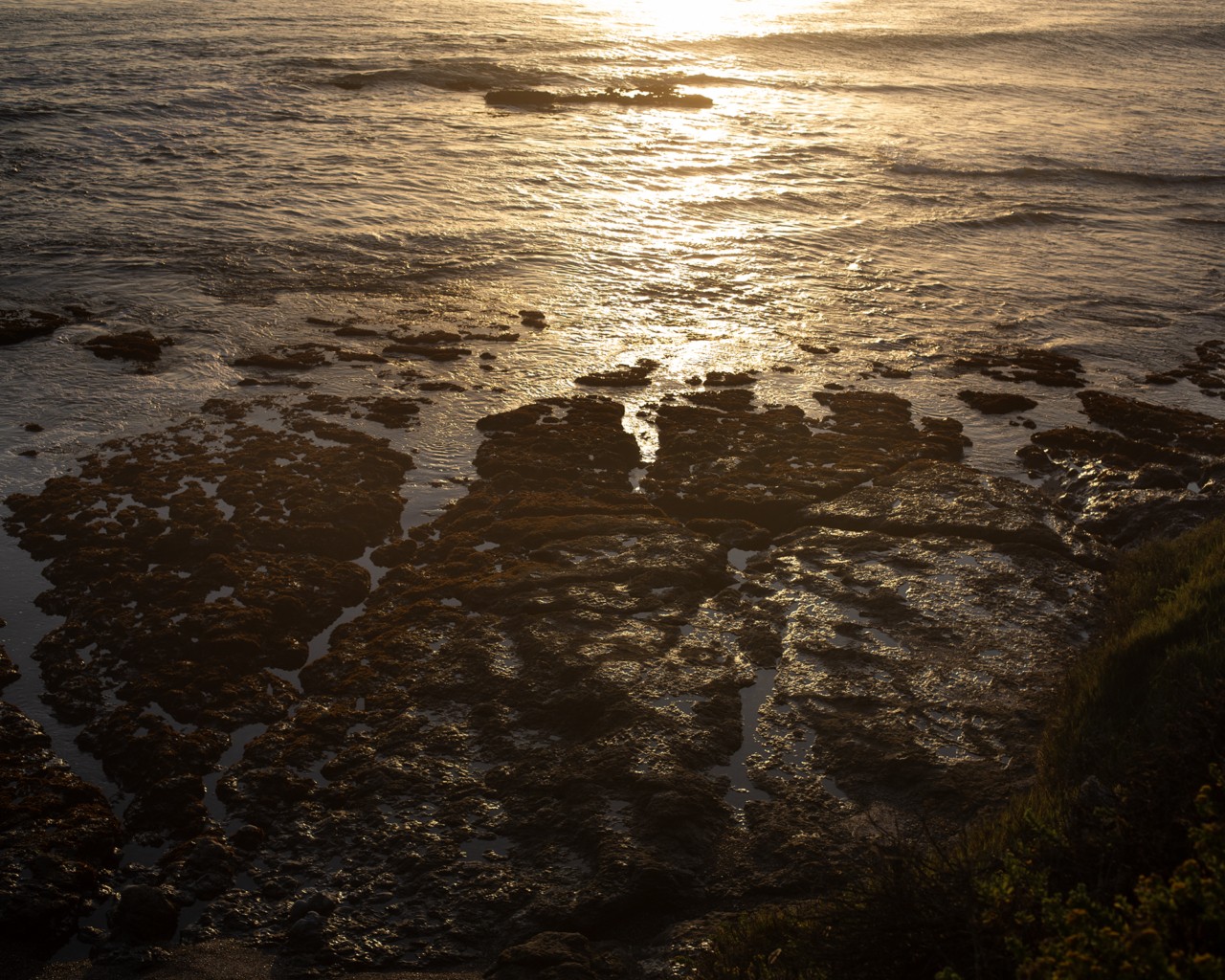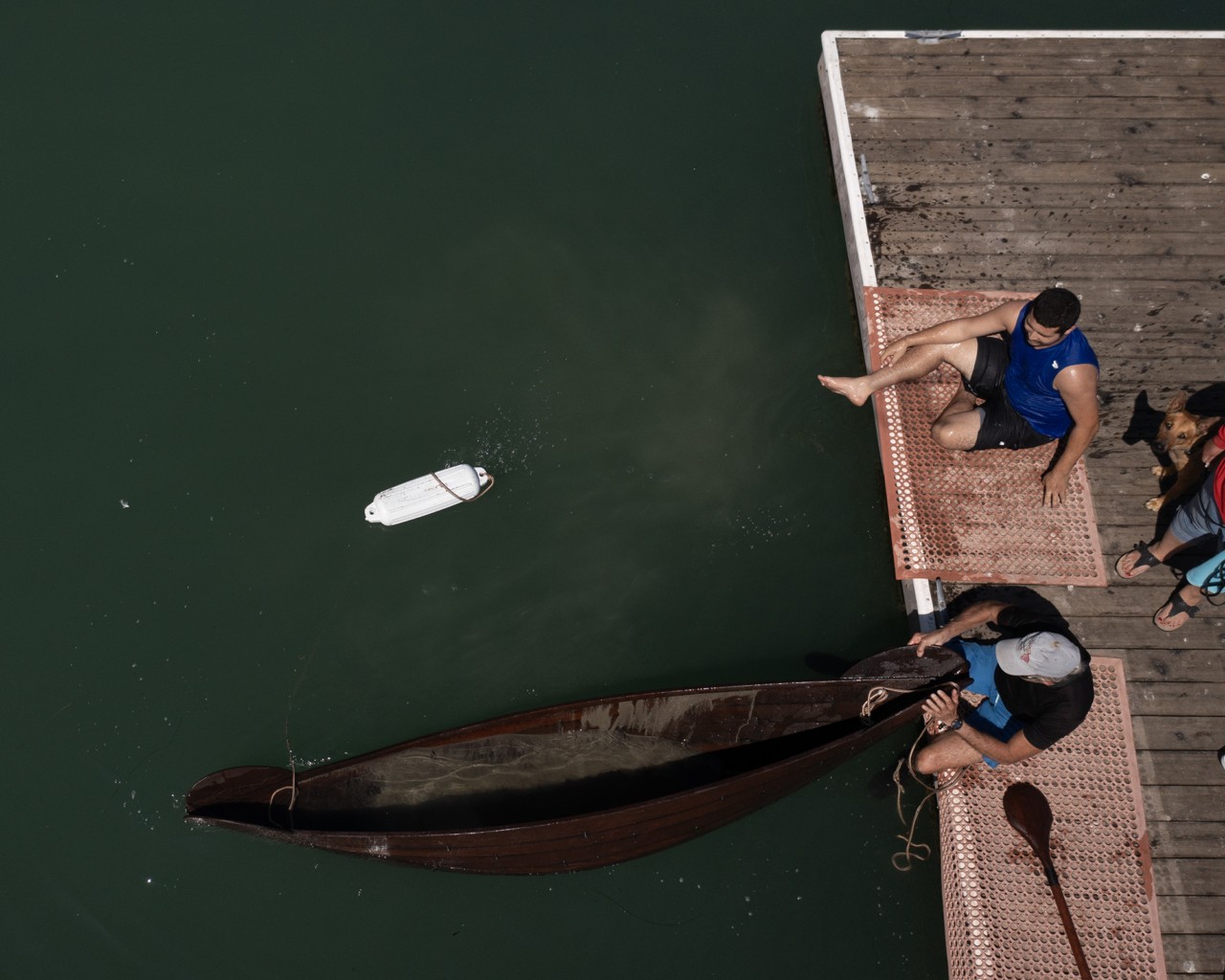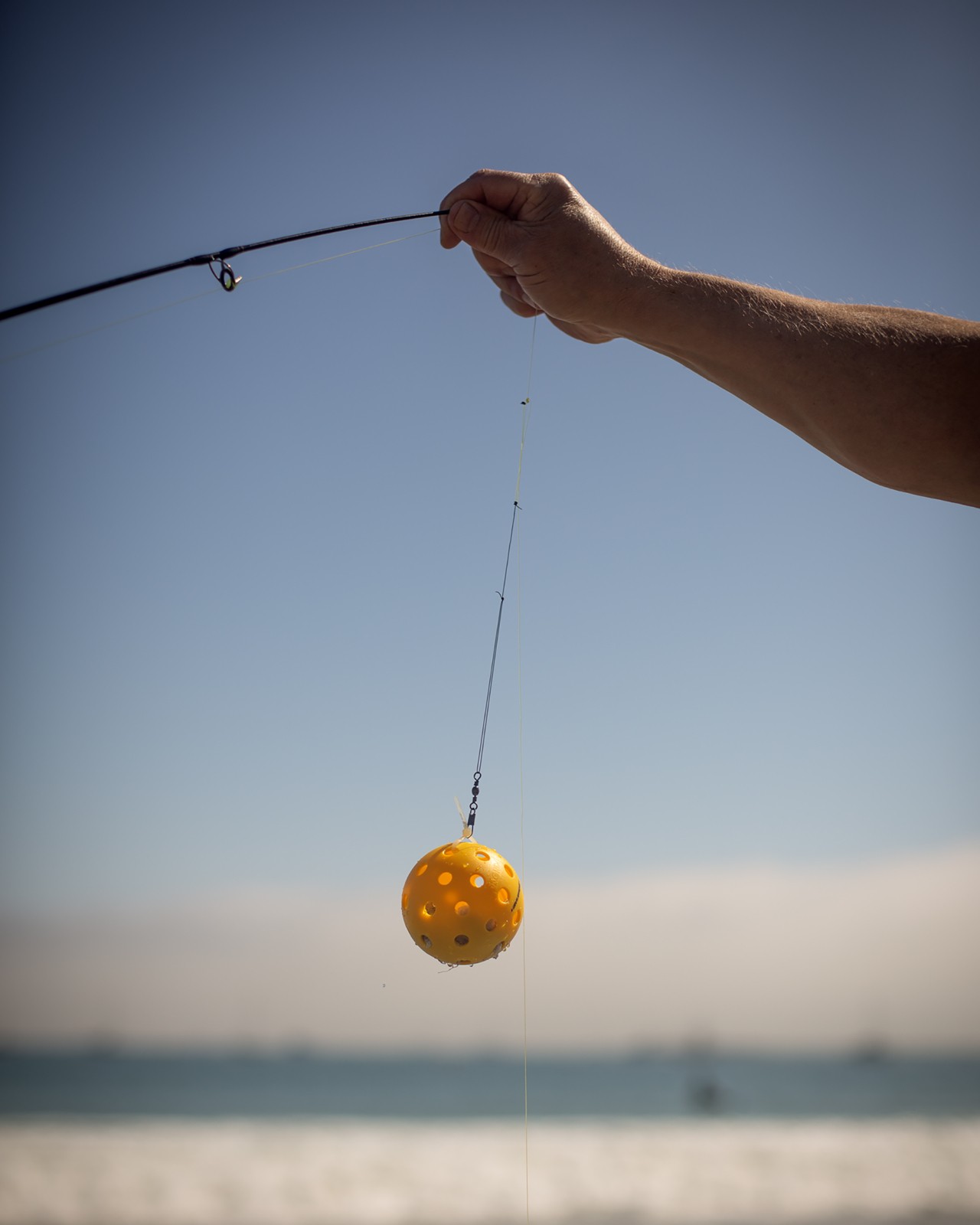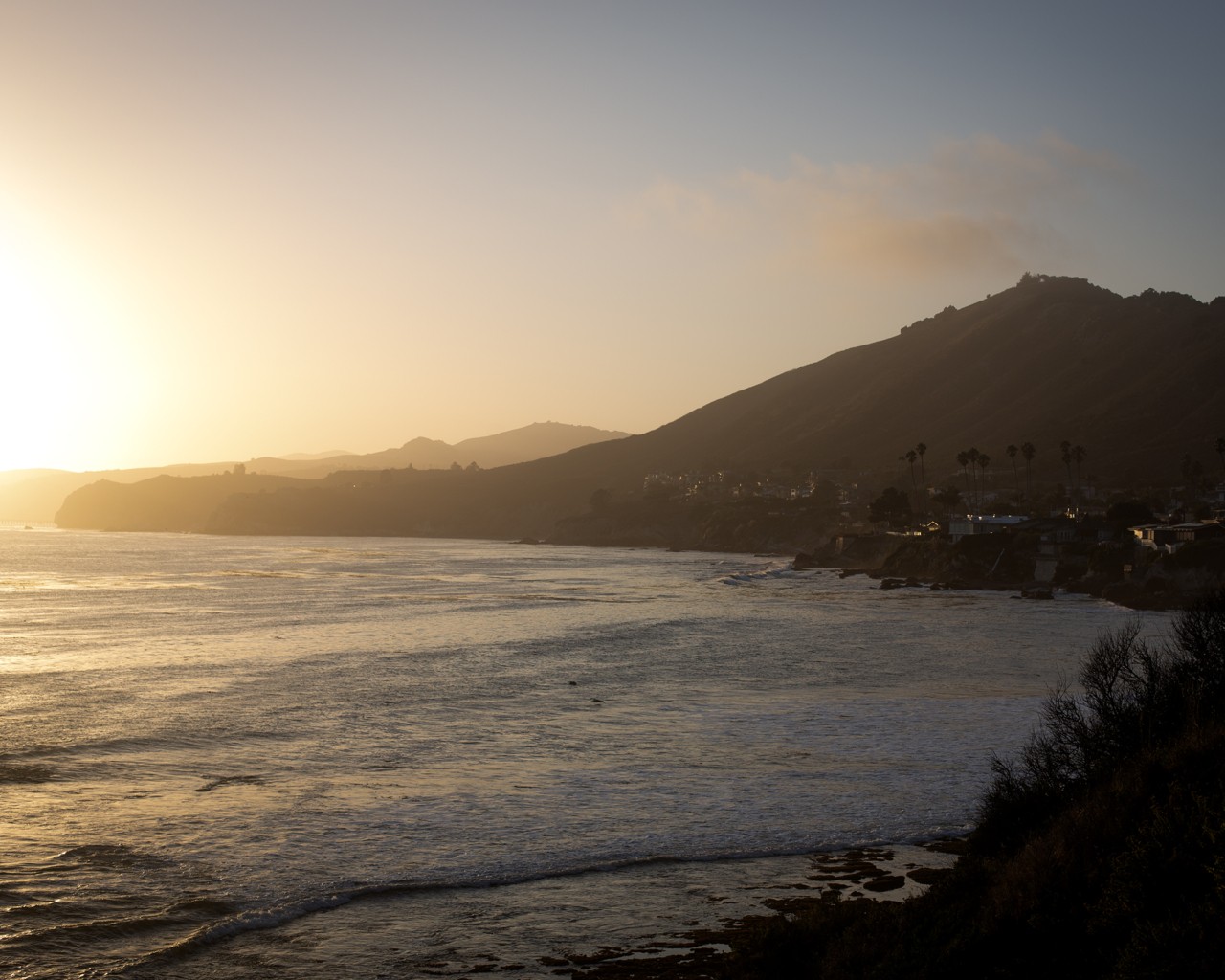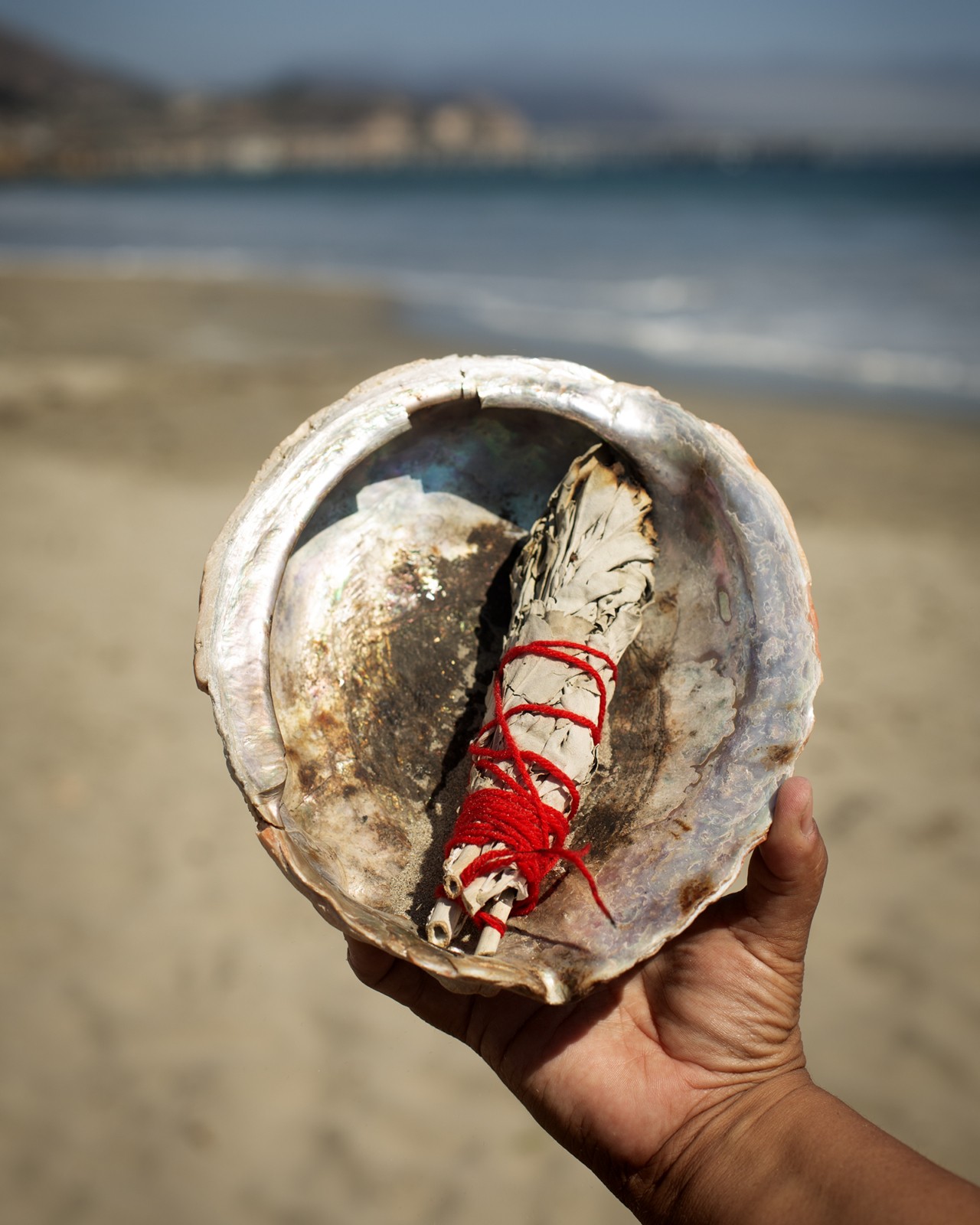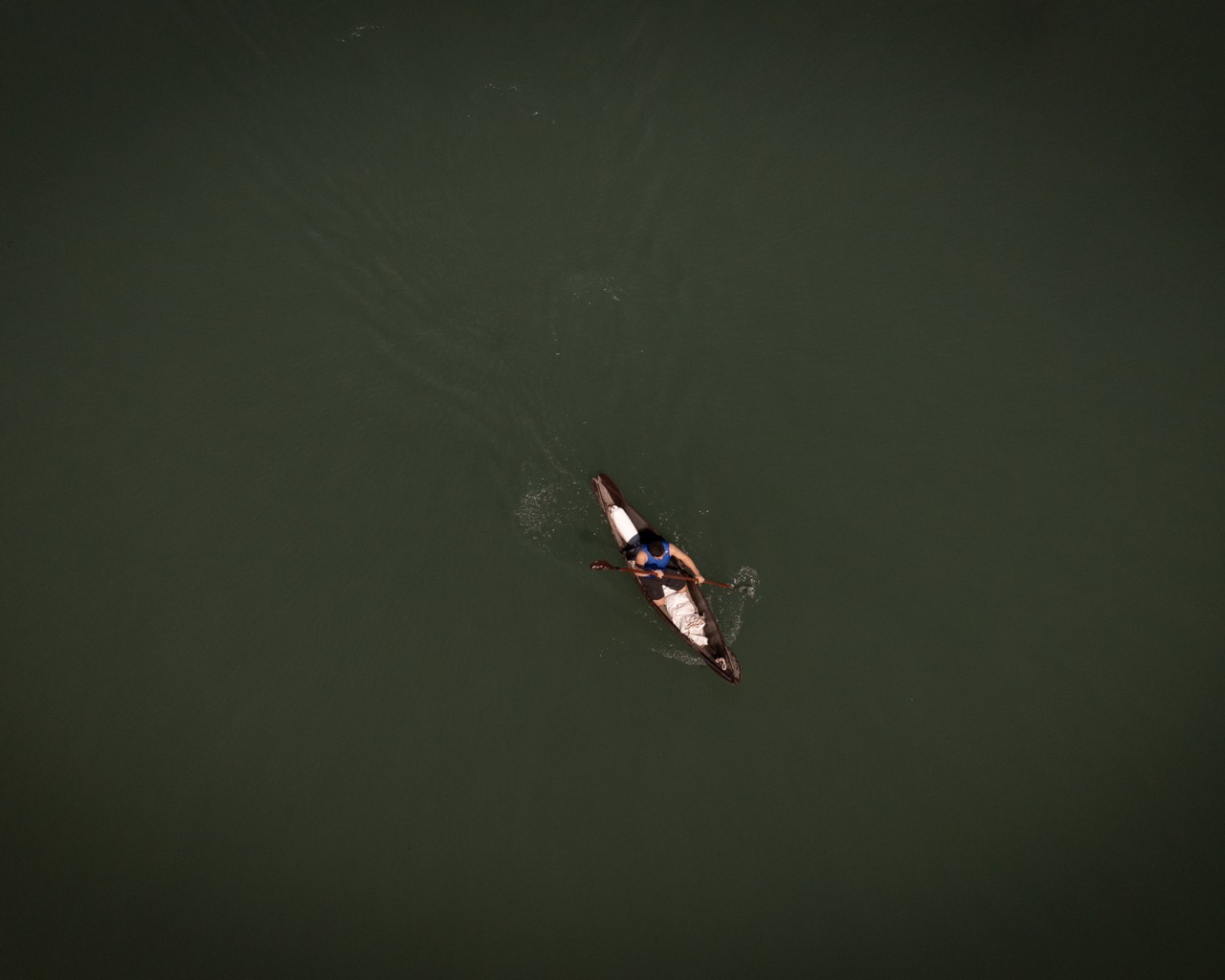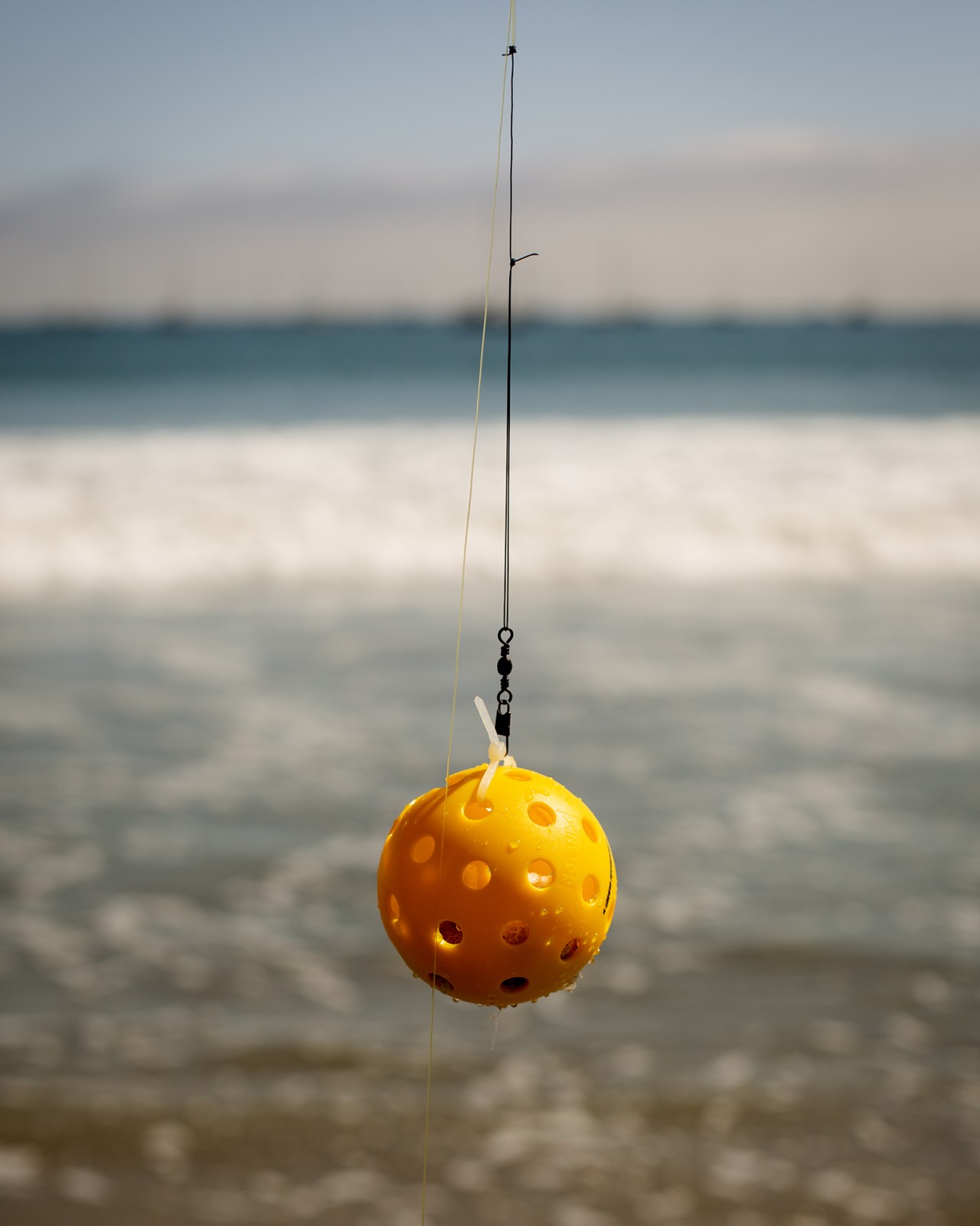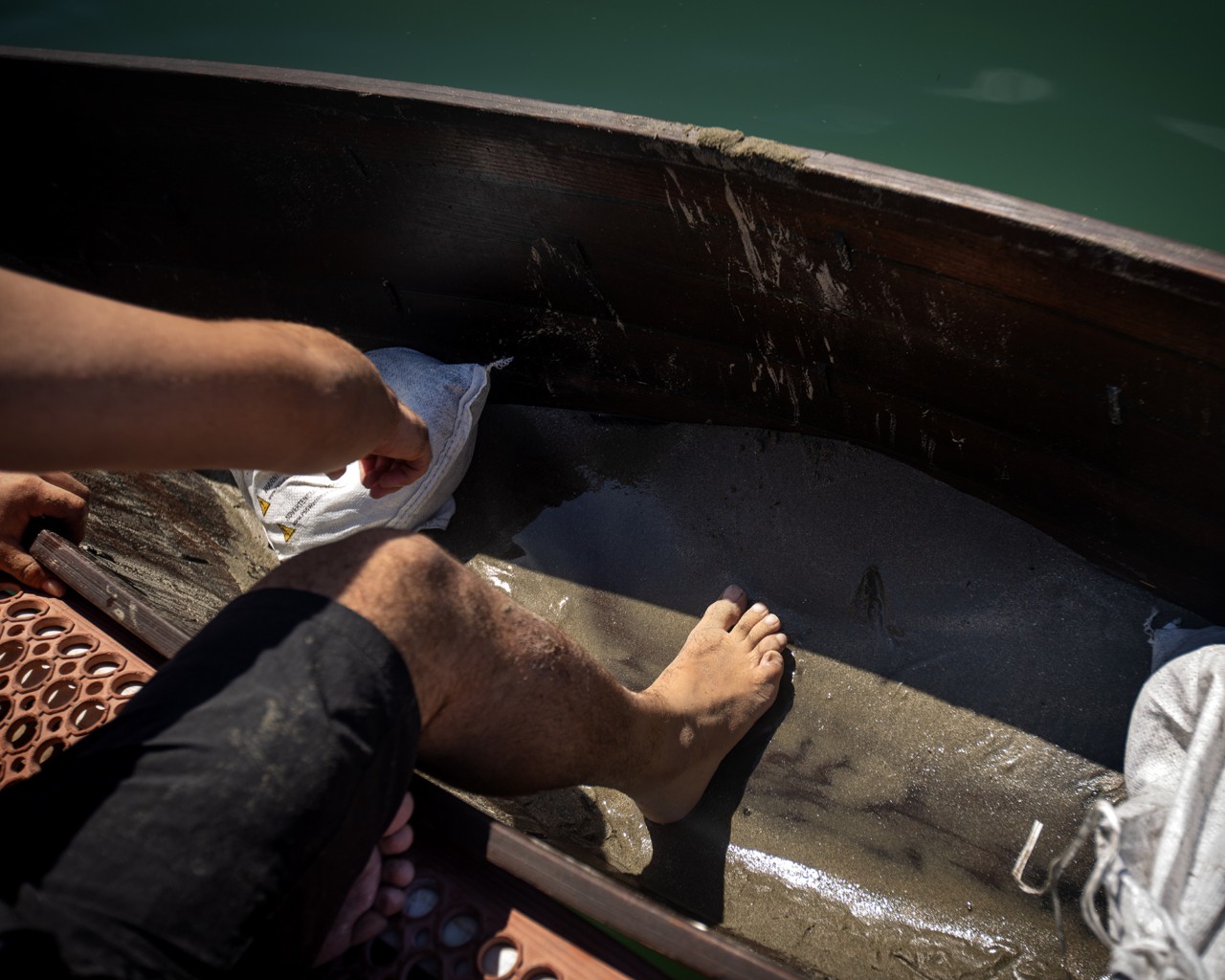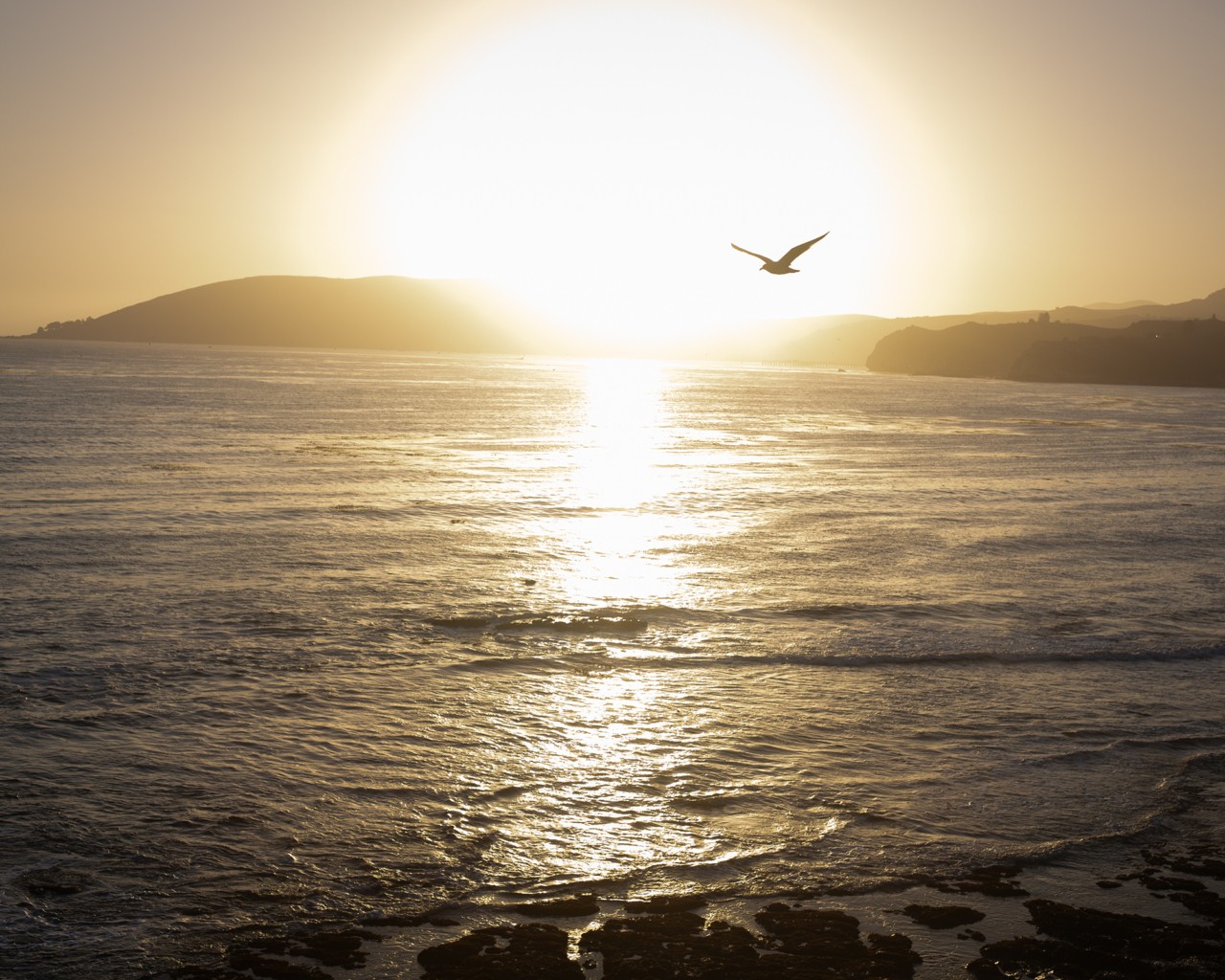

WORDS BY LUCY SHERRIFF
photographs by karla gachet
Joseph Lopez drags the wet sandbags out of the small redwood canoe, dumping them on the shore of Fisherman’s Beach, a small cove on the central California coast, huffing with each tug. He crouches down and painstakingly refills each one. The process is an art which must be perfected. Lopez empties out the saltwater that the tomol—the Chumash word for canoe—has taken onboard. He reloads the six foot vessel with the four sandbags, which act as ballasts.
It’s laborious work, and Lopez discusses with Stephen Palumbi, a Stanford University marine biologist, whether he should even be heading out on the ocean again, as the swell is larger than expected. “We have to listen to the ocean,” Lopez says, “and I feel like she’s telling us that today isn’t the day to go out.”
Lopez has already twice brought the tomol into land prematurely. The narrow, handcrafted canoe—which the tribe calls Little Sister—had taken on too much water and started to sink.
But Palumbi, who has been briefing Lopez on collecting marine samples from the ocean as part of a new collaborative science project with the tribe, isn’t disappointed. “Today’s about figuring everything out, making mistakes, learning,” he says. “And boy did we learn a lot about that boat!”


Today—which started as a cool, misty morning, cloaking the Pacific in a thick fog until the sun finally broke through the clouds in the early afternoon, shimmering on the crashing waves—is a first for both Lopez, a member of the Northern Chumash Tribal Council, and Palumbi, a professor of marine sciences at Stanford’s Hopkins Marine Station. Palumbi is working closely with the tribe to roll out a capture-free method of assessing marine biodiversity using environmental DNA—or eDNA. This involves collecting small samples of soil, water, or any other physical substrate and sequencing the genetic material that living organisms might have shed into it.
This sampling will be key in the tribe’s fight to designate a 5,600 square mile marine sanctuary off the Central California coast, which is currently in its public comment phase. The tribe hopes to protect the ocean from more oil drilling and offshore wind farms. “Doing this sampling before the sanctuary is designated, and for the first 50 years after it’s designated, means we can track exactly how this kind of protection helps our oceans,” says Violet Sage Walker, chairwoman of the NCTC, who is the driving force behind both the collaboration and the sanctuary. “We couldn’t be doing this on our own, we need to work together with different communities who have the same goals as us.”
Usually, Palumbi’s team uses $5,000-a-day boats, which can’t always access every area, and, of course, are extremely expensive. Although he has worked with tribes before, Palumbi says this time is different. “They see a value in what we’re bringing to the table. Usually we’ve asked for permission to access and study other tribes’ land, but it was never that collaborative. But now,” he adds with a chuckle, “it feels like working with extended family.”

“We have to listen to the ocean, and I feel like she’s telling us that today isn’t the day to go out.”
In recent years, Western scientists have been collaborating with Indigenous communities in a new symbiotic form. Whether it’s U.S. Forest Services working with tribes to practice controlled burns and mitigate wildfire, or the Fish and Wildlife Service helping release California condors back into the wild, it seems as if the science community and government agencies are finally valuing Indigenous ecological knowledge in protecting the environment.
“The reason why this has taken so long is because we have different value systems,” explains Walker. “There’s a value put on college or professional education, whereas our values are based on real world learning and knowledge passed down from our elders. Those two things have not merged yet but they are starting to. People are beginning to realize the value of knowledge sharing and experience and memory.”
This merging is important, Walker continues, because it directs research towards topics that are useful in the real world. “We can directly affect the state of our abalone, for example. By water sampling, monitoring growth and behavioral habits, we can help the abalone survive and thrive by changing how we harvest them. And that kind of research and science is very meaningful.”
Traditional ecological knowledge, also known as native science or Indigenous science, has been around for centuries. And yet it has been all but ignored by the science world until recent times.

Indigenous science itself is a complex and loaded phrase. Science is a Western word, not one that belongs to people who have lived on and studied this land eons before white colonizers arrived. As Robin Wall Kimmerer, environmental scientist and member of the Citizen Potawatomi Nation, puts it in her novel Braiding Sweetgrass: “Getting scientists to consider the validity of Indigenous knowledge is like swimming upstream in cold, cold water. They’ve been so conditioned to be skeptical of even the hardest of hard data that bending their minds toward theories that are verified without the expected graphs or equations is tough.”
Regardless of the term used—whether it’s native science, traditional ecological knowledge, or Indigenous science—“it’s vital to show respect for this information,” says ethnobotanist and Native scientist Linda Black Elk. “Many researchers are reluctant to consider the contributions of Native science because they do not understand the methodology behind it,” she explains. “However, Native science has at its foundation the very same scientific method that we, as researchers trained in the Western world, all hold so near and dear.”
The Latin root of science—scientia—means knowledge in the broadest sense. Terms such as Western Science only entered the public lexicon towards the end of the 19th century. And tribes, who monitor and perceive changes in their environment on a daily basis through their natural, organic relationship with their surroundings, have been doing it for centuries.

“I’m a scientist, sure,” shrugs Jamie Holt as she peers down at the dead salmon, whose bulging glassy eye listlessly stares at the blazing sun. It’s an unusually cloudless day upstream on the Klamath River, which can often be covered in the thick layer of fog that drifts upstream from the chilly Pacific. Holt pulls out a measuring tape from a back pocket, and clocks the salmon’s girth, length, and gills: it’s underweight, as is the norm these days.
She rocks back on her heels and grunts as she uses her trusted walking stick to stand—she has bad knees, and the braces she wears don’t help much. Holt is a rarity: she is an Indigenous biologist, working for her tribe, the Yuroks, a Native American community whose California reservation skims the Oregon border and encompasses vast swathes of the Klamath River. For most tribes, their in-house biologists are Westerners who come from outside to help study and track the environment, but not Holt.
The Yuroks are known as the Salmon People; salmon is in their origin story, in their lifeblood. Holt has been documenting the catastrophic decline in chinook salmon for years. She doesn’t think anything of doing so. “I do science, sure,” Holt continues. “But I’ve been doing this for decades,” she says, waving her arm across her small team of scientists, both Yuroks and non-natives, who are diligently examining bits and pieces of fish through a microscope onboard a small, blue boat. “It’s just what we do. Everyone else calls it science… it’s just what we have done for centuries,”

“We’re doing our best with what we’ve got. And now, non-Native communities are learning from us.”
What’s new is that they’re now being approached by government agencies desperate for help managing the land in the face of an increasingly inhospitable climate. Managing harsh conditions is nothing new for many tribes, who have suffered through centuries of racism. “Everybody knows we were handed the most hostile, most inhospitable, most unfarmable land,” says Frankie Myers, chairman of the Yurok Tribe. “But we’re doing our best with what we’ve got. And now, non-Native communities are learning from us.”
One example is prescribed burning, an age-old method used by tribes which involves lighting small, controlled fires to clear downed trees, control plant disease, and reduce wildfire. Many tribes even have their own fire management agencies. But in the early 1900s, government agencies doubled down on their fire suppression policies, demanding that all fires must be put out by 10 a.m. the next day. The policy stuck for decades, and it’s been a difficult mindset to untangle.
When the Bootleg fire ripped through southern Oregon—and the land of the Klamath Tribes—in 2021, so large it generated its own weather, a small patch in the Black Hills remained. In the years prior to the fire, the chairman Don Gentry had worked with the USFS to practice prescribed burning. The areas they had applied controlled burns, or “good fire,” emerged unscathed. Green and healthy trees were surrounded by charred remains of the untreated forest. The fire, although catastrophic, helped validate the decades of work that Indigenous practitioners of prescribed fire had put into the land.

“I’ve learned a whole lot from working with tribes…It’s giving me a whole new perspective.”
“We need to be considered as co-managers of the forest,” Gentry says. “We need to be able to practice burning, and fight fire with fire, because we have shown, over centuries, that it works.”
Agencies like the US Forest Service are finally beginning to work with tribes in earnest. “We work with tribes in many ways,” says John Winn, spokesperson for the USFS. “The agency’s work includes the expansion of tribal co-management opportunities, support of tribal self-governance, and collectively, we are upholding our trust obligations. With that being said, there is always more work to be done. We can only begin to understand the important connection with tribes, how the cultural and spiritual significance of federally managed lands and waters and the wildlife and resources we manage, contribute to their way of life.”
This once-ignored TEK, Indigenous science, native science—whatever you want to call it – is gradually starting to shape how the government is managing land.
A true symbiotic relationship is one that flows both ways. Collaborating with Western scientists has been key to the Northwestern Band of the Shoshone Nation, who are restoring 700 acres of land they purchased in 2018. The land is sacred to the tribe, it’s a burial ground—and the site of the biggest massacre of Native Americans by the U.S. military. For the Shoshone, owning the land, stewarding it, and restoring it to its original state was both a healing process and a cultural lifeline for the tribe.


“It was important to us to take care of the land, to take care of the dead,” says Darren Parry, former tribal chairman who leads the project. “So the day after we closed on the sale of the land I went and visited two professors in the natural resources department at Utah State University.” His first question to the academics was: “I want to restore the land to what it looked like in 1863. Is this feasible?” The academics jumped at the chance to help, and visited the site the following day. “We walked the land, they had their notebooks out and they’re making notes on invasive plants that have come in. And at the end of it, they say: We can absolutely do this, we can help.”
With the help of the university, the tribe is rerouting waterways, removing half a million invasive Russian olive trees, working with farmers upstream to create riparian buffer zones, and reintroducing beavers—an animal Parry adores—and hopefully bringing back the Bonneville cutthroat trout, a native species that once flourished in the basin.
“It’s going to take a long time,” Parry added. “One of the professors told me it’ll be an ongoing project for decades. But she also told me it will be a living, learning classroom for the university.”
Is this new kind of partnership the future of science? “It is,” Palumbi answers definitively. “I’ve learned a whole lot from working with tribes…It’s giving me a whole new perspective. Not just on how to do science—but why we do it.”
Towards A Symbiotic Science
